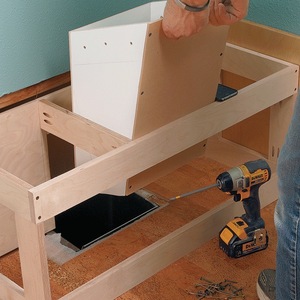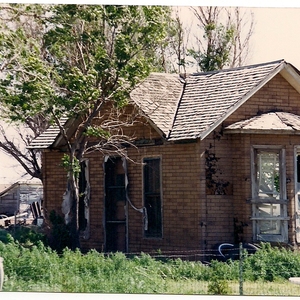*
I’ve got a small weeping leak in the slab floor of my house. Clearly, it’s been active for years, small drip into my garage, which is under the house. Now i’ve cut open the floor and have access to the piping, I’ve solidered a leak which is on a joint but another reducing tee fitting is also leaking. Because of the location replacement isn’t possible, does anyone know of a product which I can use to seal the leak and will stand the high temperature of a radidor heating system. THIS IS A UK PROBLEM.
Discussion Forum
Discussion Forum
Up Next
Video Shorts
Featured Story

The "She Build" initiative is empowering women in Seattle, WA by ensuring they have safe, healthy homes.
Featured Video
How to Install Exterior Window TrimHighlights
"I have learned so much thanks to the searchable articles on the FHB website. I can confidently say that I expect to be a life-long subscriber." - M.K.

















Replies
*
Hardware stores in my area of the US (Washington DC) sell a combination clamp/rubber gasket which would surround the leak and prevent any further drips - at least for some period of time. This "quick-fix" device is meant to surround a straight length of pipe/tube but surely would work when fitting one end of the clamp over the female section of the tee and the other end 3 or 4 inches down the pipe.
This response is based on your statement that replacement is not a possible solution.
Good Luck
*There's a big flap going on here in San Antonio concerning in-slab leaks. Seems that the city code requires a plastic sleeve around the copper pipes in the slab, but some builders are not installing it and the city building inspectors were not catching the problem. Well, to put it like the editorial in the paper said, the inspectors were waiving the requirement. Now the lime in the concrete is reacting with the copper and problems are popping up all over town. Looking at the sparse data in the paper, looks like most of the problems are in houses 5-7 years old.
*Mark: For problems like nailholes, here's a solution: I've sometimes had success with cutting a repair coupling (one with no stop on the inside) in half, lengthwise. The trick is to cut it without mangling it too much. Then brush the heck out of the inside of the half coupling and the outside of the pipe. Add flux. Put pencil marks to the side so you can confirm it is in the right position. Hold in place with wire twisted tight. Solder normally. To get all the water out of the pipe, it will helpful to run a shop vac on one end, with the other end open. For a long time (10 minutes) for such a long pipe run.The bummer is that this may keep happening in other locations with increasing frequency. Here's hoping that it was just a bad joint in the first place (cold, no flox, imperfect brushing, whatever) and not a systemic problem. -David
*If the problem is a one off, a single defective part or bad installation, a good patch may be the way to go. Not being able to see it, especially the part about not being able to replace the fitting, I really don't know any easy solutions. Plumbers in your area should have seen this problem before and may have a quick fix.If, on the other hand,as suggested by others this is corrosion related or poor materials you may be looking at the most obvious of many, or soon to be, leaks. In that case replumbing may be the cheapest, in the long run, solution. Replumbing is not cheap but neither is coming home from vacation to a flooded house. The peace of mind may tip the balance toward the the more expensive but permanant fix. Consult with several plumbers familiar with houses built in your area as they may have an idea of the general track record of similar problems and possible patches. Best of luck to you.
*why is ANYONE putting copper heating pipe in cement?!?!I thought that lesson was learned from the huge failure rate at Levitown (built in the 50s, all leaked by the 70s). Simple chemistry of copper reacting with the ingredients of concrete.Roth (and others) developed their plastic tubing for radiant heat specifically for that reason.My sympathies to anyone dealing with an older system installed before alternatives were available. I guess no sympathy for someone building that way today.
*mr kerr - you might be jumping to an incorrect conclusion. I didn't see any reference to this being a radiant heating problem. Here in the southwest, almost all houses are concrete slab on grade, and all the plumbing is in the slab.
*Yes, my newly purchased 1950 house is slab on grade, with the original plumbing abandoned in place in the slab. The re-pipe job was run thru the attic. The original drain and waste stuff is still in use, and I'm crossing all available fingers that no leaks will be found.-- J.S.
*What about brazing?
*xJohn - that's how most folks here are making repairs, especially when they discover that the repair cost will be upwards of $10k. Since it rarely freezes here, wtaer pipes in the attic are not a problem, but to get cool tap water in August you have to let the water run a bit, kind of the opposite for getting hot water in the shower.
*Is anybody tried to thread pex through the pipes? (Not for heating, but for domestic water).
*To state the problem in more exact terms. The hole I have made in the slab is about 4 inches deep and about 12 x 10. It's right next to a shared party wall, and under a set of built in cabinets (could it get much worst!). The ideas I've had, and would like feedback on are as follows.1. Some type of leak sealing chemical put into the header tank to flood the system with sealant. Like the stuff they sell for car radiators (never tried it myself but told it's not very good.)? Even the old wife's tale about the egg white?2. flood the entire hole with lead, the problem with this is if it doesn't work the removal will be a pain in the ass!3.live with the leak - fix the hole - wait for summer - sell the house!......just kidding!
*what is this a product? Can it be used for heating systems?
*Not viable, but thanks,Mark
*Thanks, but after draining the system and repairing two leaks I've refilled and found another leak right on a reducing tee fitting. Your suggestion has another couple of problems. I'm American but have lived in the UK for about 12 years, all of Europe in metric now. but, when the house was built we were clearly imperial so the pipes with the problems are half & three-quarter inch. The ONLY fitting available here are 13mm & 22mm. Also absolutely no hope of finding a sleeve coupler without a stop in the middle. May I should ask by folks in the US to send me some "normal" fittings for Christmas!!! thanks for your time.Mark
*Mark, do they have epoxy putty available there ? ie, here we can get JBWeld in the tubes as liquid, and mix the two halves together, or we can get it in 'putty' form. It is a stick of putty with the two parts separated God knows how. You tear off a piece and knead it together until you have a uniform colored putty.I have used this to fix leaks both in domestic water, and in car radiators, and it has never failed.The trick is to get the fitting cleaned off extremely well. Use emery cloth and get all the way around the pipe. Then use something like brake cleaner to clean it off with. (Brake cleaner is like carb cleaner, only the brake cleaner dries without leaving a residue. You don't want any residue.) Then, knead some putty up, and apply it all around the pipe in the affected area.This will take care of the immediate problem. But as others have said, you will continue to have problems cropping up. You may eventualy have the whole slab chipped out, the pipes all sleeved, or epoxy puttied, and then the slab filled back in. I supposed you could continue to chip out portions at a time and do the repairs as here, but wouldn't it be better just to replace the system ?
*Mark, you need to take the joint apart and clean it so it can be soldered fully. But taking it apart can't be done with ease. Pick up two couplings with out the stops. Cut out a small section so you can take the leaking joint apart then clean up the section you removed + the in floor ends. Slide on the couplings with flux and assemble it all in the floor. Sweat the joints and just to be safe if you can air pressure test the pipes (30 PSI max).
*Mark, out here in California (Palo Alto in particular) there were a large number of Eichler houses built in the 1950's. Eichler, the architect or developer that designed and built them, installed copper-pipe-in-slab heating in all of them. My understanding is that 100% developed multiple leaks due to to the chemical action of the alkaline concrete on either the copper or the solder or both, and perhaps also to movement. They have all been shut down and replaced (not easily) with other heating methods, because repair was temporary at best. You might be able to contact the building inspectors in Palo Alto and ask them for advice, but I suspect Luka is right: you probably should just replace the system. Good luck.
*I have a great plumber that I use, and showed him your post. He would enlarge your hole and dig down as deep as you can to get under the offending fitting. He could fit a cutter behind the "T" and solder it in a flash. I suspect your hole just isn't big enough. Lessons on copper and concrete. They don't mix. Out here in SoCal, all plumbing is well below the slab, usually about 6" and is sleeved and covered with pea gravel. When it does go through the slab, as all plumbing must, it is sleeved in a foam rubber jacket. Good Luck!
*The chemical you're thinking of is called water glass. My father used it about 40 years ago to seal pinhole leaks in a copper steam boiler, which operated at 125 psi.-- J.S.
*
I've got a small weeping leak in the slab floor of my house. Clearly, it's been active for years, small drip into my garage, which is under the house. Now i've cut open the floor and have access to the piping, I've solidered a leak which is on a joint but another reducing tee fitting is also leaking. Because of the location replacement isn't possible, does anyone know of a product which I can use to seal the leak and will stand the high temperature of a radidor heating system. THIS IS A UK PROBLEM.